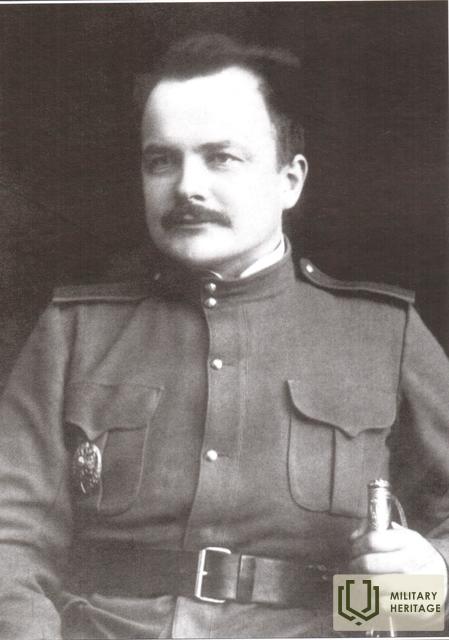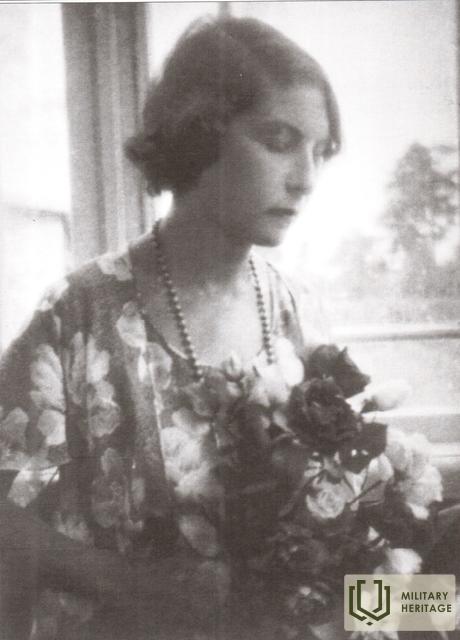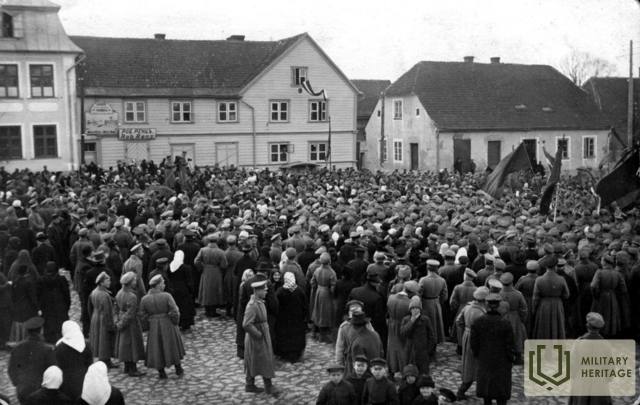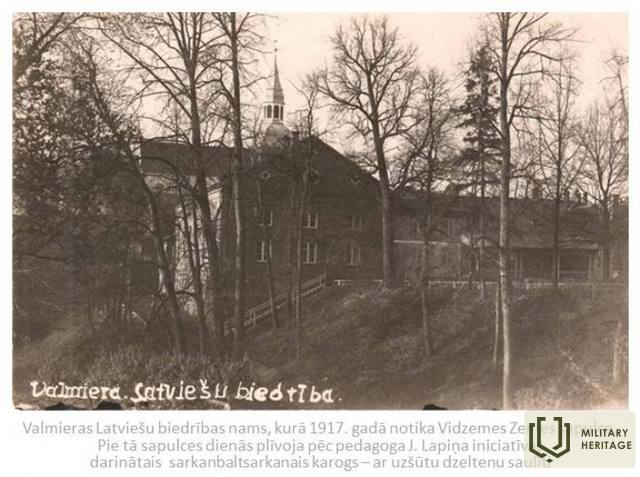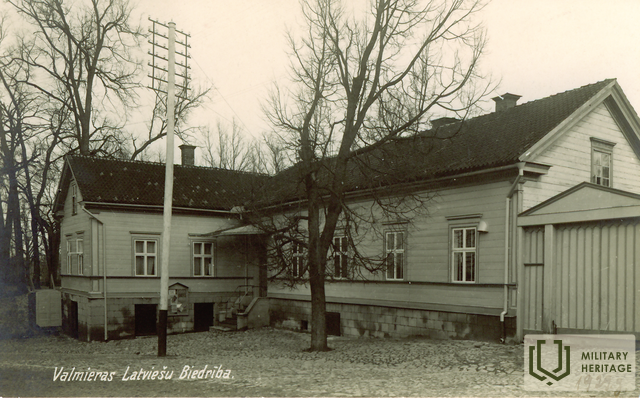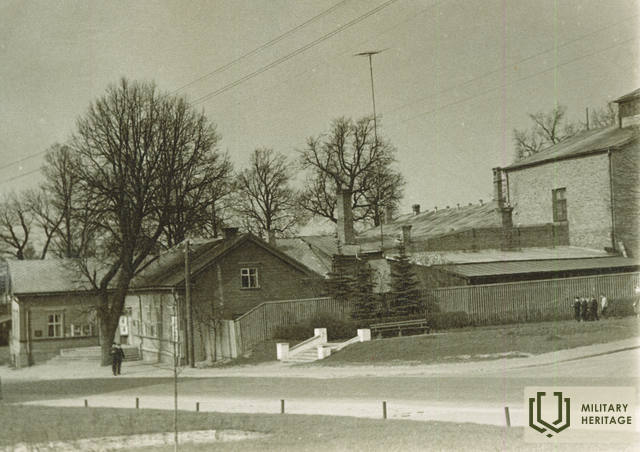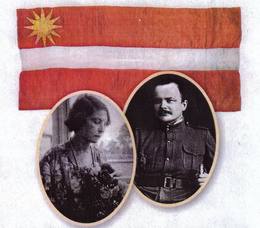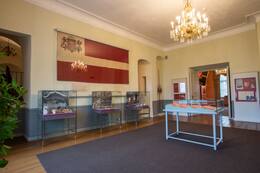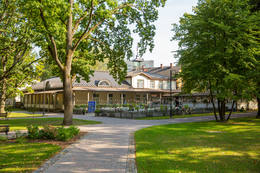Jānis Lapiņš ir pirmasis Latvijos raudonos, baltos ir raudonos vėliavos projektas
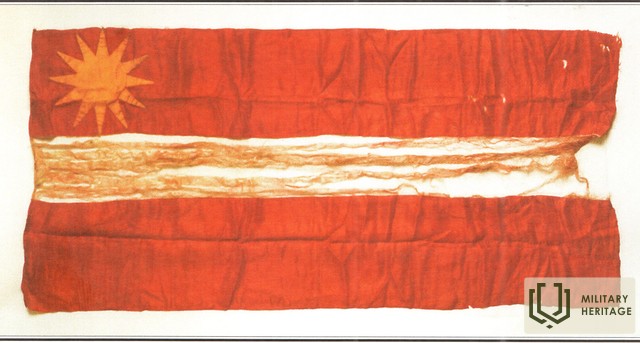
Latvijos nacionalinės vėliavos sukūrimas vyko Pirmojo pasaulinio karo metais. 1915 m., kuriant Latvijos šaulių batalionų vėliavas, pavieniai menininkai siūlė raudonas, baltas ir raudonas vėliavų spalvas. Po pedagogo ir žurnalisto Janio Lapinio sumanymo, raudonai baltai raudoną vėliavą 1916 m. antroje pusėje pagamino jo mokinė, Valmieros pabėgėlių prieglaudos mokytoja Marianna Straumane. Tai pirmoji žinoma ir iš tikrųjų pagaminta Latvijos nacionalinė vėliava, kuri taip pat išliko iki šių dienų.
Vienas uoliausių Latvijos nepriklausomybės idėjos populiarintojų buvo Veselavoje gimęs mokytojas ir žurnalistas Jānis Lapiņš (1885–1941), nuo 1915 m. rudens dirbęs Valmieros prekybos mokykloje. Be įprastų studijų, jam teko tvarkyti ir pabėgėlių reikalus. Pabėgėlių aprūpinimo organizacijos „Ziemeļpalīdzība“ biuras yra už pilies griuvėsių, Maršnerių namuose, viename geriausių mieste. Kuržemės pabėgėliai Lapinį labai gerbė kaip pabėgėlių pareigūną, prisimena Kaugurių parapijoje gimęs, tuomet Latvijos mokyklų asociacijos prekybos mokyklos mokinys rašytojas Kārlis Eliassas (1899–1985): „“
Janis Lapinis daugelį sužavėjo Latvijos raudonai baltai raudonos vėliavos idėja. Šią vėliavą jam 1916 m. antroje pusėje pagamino (išsiuvinėjo) Marianna Straumane (1896–1985), Valmieros pabėgėlių vaikų prieglaudos mokytoja, kuri vėliau tapo J. Lapinio žmona. 1917 m. Lapinis įkūrė Valmieros Liaudies universitetą ir dalyvavo visuose svarbiausiuose viešuose renginiuose. Mokytojo namuose Aleksandros gatvėje ilgesnį ar trumpesnį laiką gyveno arba lankydavosi Latvijos kultūros darbuotojai Jānis Akuraters, Kārlis ir Lizete Skalbes, Pauls Dāle, Ernests Blanks, Linard Laicens ir kt.
Kaip įrodymą apie augantį latvių pasitikėjimą savimi, raudonai baltai raudona vėliava plevėsavo virš Valmieros latvių draugijos pastato per Vidžemės žemės susirinkimą 1917 m. kovo mėn. Vienas uoliausių raudonai baltai raudonos nacionalinės vėliavos populiarintojų Janis Lapinis taip pat dalyvavo naujosios Latvijos valstybės paskelbimui skirtame susirinkime Valmieroje (Vecpuišu parke)! Kreipdamasis į Valmieros moksleivius, jis vaizdingai pasakė, kad „visos senovės latvių žmonių svajonės artėja prie išsipildymo, bet ir nugrimzdę Šviesos rūmai turi iškilti“. Valmieros mokyklų jaunimas nė nenumanė, kokie pranašiški bus Lapinio žodžiai, nes paskelbtąją Latvijos laisvę dar reikės iškovoti!
XX a. 3–4 dešimtmečiais vertingas reliktas buvo saugomas Lapinių šeimoje, o sovietmečiu kruopščiai paslėptas. Vokiečių okupacijos metu Marianna su dukra evakavosi į Vokietiją kartu su gamykla, kurioje dirbo, žinoma, pasiimdamos ir vėliavą. Po karo, grįžus į Latviją, ją teko slėpti ilgus metus. 1997 m. Marianna ir Janio Lapinių dukra Lija Poga padovanojo būtent šią, tuo metu jau daugiau nei 80 metų senumo, vėliavą Cėsių muziejui. Pažymėtina, kad pirmoji kronikoje paminėta vėliava buvo pagaminta Cėsyse 1279 m. kaip ideologinis mūsų Latvijos vėliavos prototipas, tačiau pirmoji nacionalinė vėliava buvo pasiūta ir pagaminta Valmieroje 1916 m.
Informacinė ir iliustracinė medžiaga iš Pumpuriņš T. Raudona, balta ir raudona – Latvijos vėliavos spalvos. Cėsys, 2000. ir Valmieros muziejaus kolekcija.
https://www.valmiera.lv/lv/kultura/latvijai_100_/brivibas_stasti/janis_lapins/
Susijusi laiko juosta
Susijusios temos
Susijusios vietos
J. Lapinio, pirmosios Latvijos vėliavos autoriaus, atminimo vieta
Įsikūręs „Lejas Pintuliai“, Veselavos valsčiuje, Priekulių savivaldybėje.
Matomas paminklas Latvijos vėliavos autoriui Jāniui Lapiniui.
Latvijos nacionalinė vėliava buvo sukurta Pirmojo pasaulinio karo metu. 1915 m., kuriant Latvijos šaulių batalionų vėliavas, pavieniai menininkai siūlė raudonas, baltas ir raudonas vėliavų spalvas. Po pedagogo ir žurnalisto Janio Lapinio sumanymo raudonai baltai raudoną vėliavą 1916 m. antroje pusėje pagamino jo mokinė Marianna Straumane, Valmieros pabėgėlių prieglaudos mokytoja.
Tai pirmoji žinoma ir iš tikrųjų pagaminta Latvijos nacionalinė vėliava, išlikusi iki šių dienų.
2014 m. Priekulių rajono Veselavos valsčiaus „Lejas Pintuļi“ buvo atidaryta atminimo vieta prieš vėliavą autoriui Jāniui Lapinui.
Pirmoji žinoma autentiška Latvijos nacionalinė vėliava, kuri buvo slapta įvežta į Rusiją ir kruopščiai paslėpta sovietų ir vokiečių okupacijų metu, šiuo metu saugoma Cėsių istorijos ir meno muziejuje . Ją 1997 m. padovanojo jų dukra Lija Poga.
Cėsių istorijos ir meno muziejus Cėsių Naujojoje pilyje
Cėsių istorijos ir meno muziejus yra įsikūręs pačiame Cėsių senamiesčio centre, Naujojoje pilyje. Muziejuje veikia nuolatinė istorijos ir interjero ekspozicija „Cėsys – Latvijos istorijos simbolis“, kurią sudaro du teminiai skyriai: ekspozicija „Raudona-balta-raudona vėliava Cėsių ir Latvijos istorijoje“ aiškina Latvijos nacionalinės vėliavos istoriją nuo XIII iki XX a., patvirtintą nacionalinį simbolį, Latvijos šaulių batalionų vėliavas ir nacionalinių spalvų naudojimo tradicijas Latvijos nepriklausomybės karo metu. Parodoje „Cėsys ir Latvijos nepriklausomybės karas“ daugiausia dėmesio skiriama Cėsių kuopos įkūrimui 1918 m. gruodžio mėn., bendroms estų ir latvių kovos pastangoms 1919 m. Cėsių mūšiuose, laikui, kai Bermonto aferos metu Cėsys trumpą laiką buvo laikinoji Latvijos sostinė, taip pat Cėsių pergalės paminklo istorijai. Pabėgimo kambaryje „Cėsių mūšių legendos“ dalyviai turi valandą rasti išeitį spręsdami galvosūkius, užmegzdami ryšius ir ieškodami paslėptų daiktų. Cėsių kuopa, vienas pirmųjų Latvijos ginkluotųjų pajėgų dalinių, buvo įkurta 1918 m. gruodžio 8 d. Cėsių pilyje vyresniojo leitenanto Artūrs Jansons. Muziejaus ekspozicijoje eksponuojama Cėsių kuopai skirta atminimo lenta, atidengta 1933 m. gruodžio 8 d. Cėsių Naujojoje pilyje, kuri tuo metu buvo 8-ojo Daugpilio pėstininkų pulko ir garnizono karininkų klubo štabas.
Elnparkas ir koncertų salė „Valmiera“
Parkas yra Valmieros centre.
1914 metais aštuoni verslūs Valmieros gyventojai nusprendė tuo metu miesto pakraštyje įkurti parką su nealkoholinių gėrimų bufetu ir knygų stalu – taip prasidėjo Vecpuišių parko istorija.
Parko plėtros darbus nutraukė Pirmasis pasaulinis karas.
Jau karo pradžioje paviljono salėje buvo įkurta sužeistų kareivių ligoninė. Antrajame pastato aukšte buvo įsikūręs Valmieros Raudonojo Kryžiaus komitetas, jo centrinis aukų priėmimo punktas ir sandėlis.
Valmieros komitetas buvo vienas aktyviausių Latvijoje. 1914 m. spalį jis vadovavo 33 ligoninėms su 375 lovomis. Komitetas rinko lėšas ligoninių išlaikymui ir sužeistų kareivių gydymui, šiltų patalynės ir kelionės pinigų tiekimui pasveikusiems, sužeistų kareivių maitinimui, taip pat siuntė dovanas tiesiai į frontą. Vienas aktyviausių Raudonojo Kryžiaus komiteto darbuotojų, rinkusių lėšas, buvo Kārlis Ulmanis (1877–1942), vėliau tapęs pirmuoju nepriklausomos Latvijos ministru pirmininku.
Su Vecpuišių parku taip pat susijusi legendinių Latvijos šaulių batalionų įkūrimo istorija. 1915 m. rugpjūčio 4 ir 5 d. parke veikė savanorių verbavimo komitetas, o rugpjūčio 6 d. iš čia į mokymus buvo vežami jauni kareiviai. Vėliau iš čia į kareivius ne kartą buvo vežami ir jauni vyrai iš Valmieros bei apylinkių. Karo metu parke taip pat vykdavo įvairūs kultūros ir labdaros renginiai, tačiau visos surinktos lėšos buvo skirtos padėti nukentėjusiesiems nuo karo.
1918 m. lapkričio 18 d. Valmieroje pirmą kartą buvo iškelta tautinė vėliava kaip valstybės vėliava ir pirmą kartą sugiedotas naujasis himnas „Dieve, laimink Latviją“.
Antrojo pasaulinio karo metu Vecpuišų parko paviljono pastate buvo įrengta ligoninė, o šauliai buvo vedami į mūšius. Sovietų okupacijos metu, 1940 m. rugpjūčio 12 d., Valmieros miesto valdybos sprendimu parkas buvo pervadintas į Komjaunimo parką.
Po Antrojo pasaulinio karo architekto Freibergo suprojektuotas paviljonas buvo naudojamas ir kaip kultūros centras (iki 1966 m.), ir kaip sporto mokykla. Dešimtojo dešimtmečio pabaigoje (1998 m.) paviljonas Bakalauro parke vėl pradėjo veikti.
Restorano „Vecpuisis“ patalpose eksponuojamose nuotraukose įamžinti parko įkūrėjai.




